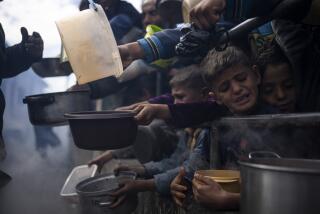To Attack Hunger, Attack Poverty
- Share via
In a dream world, each country produces according to its comparative advantage, trades on a level global playing field and has enough money to buy the surplus products of its trading partners if it needs them. There are no worries about product gluts, low prices or environmental degradation. If the problem is starvation in Africa, the solution is no more complicated than pouring more fertilizer on crops in the United States.
The real world is a very different place. Countries are not the same, and a failure to understand this obvious condition has disastrous consequences for developing a global food policy to end world hunger.
Today, the most developed countries, led by the United States but also including Japan, Germany and the British Commonwealth nations, produce more of almost everything than they can consume and must constantly seek new markets for their surplus products.
Another group of countries, including China, India, Thailand, Brazil and South Korea, can for the most part feed themselves and are becoming important exporters of both agricultural and manufactured products.
In a third group of countries, which covers much of Africa and such nations as Afghanistan and Myanmar and parts of Latin America and the East Indies, production is at subsistence or below, birthrates are high and populations are kept in check by starvation, disease and civil strife. The natural resources of these countries are typically exploited in ways that benefit the wealthy around the world. Meanwhile, the common resident goes hungry and there’s no money to buy foodstuffs from the countries that have surpluses. These are the people we think about when we hear the phrase “feeding the world.”
As this makes clear, the problem is not a lack of food in the world. The problem is that poor people do not have enough money to buy food. As simple as this concept is, it appears to completely mystify proponents of an all-out industrial agricultural model for the United States.
I have supported realistic food assistance programs for the poor and hungry, both here and abroad, for 50 years or more. In doing so, I have learned two hard lessons. First, if the fertilizer and chemical companies want to promote more production in surplus regions, then they, and not the public, should subsidize the distribution of that surplus food.
Second, even in cases where food aid shipments help the starving survive, those shipments alone will not produce lasting economic development. Without that development, the root cause of hunger--poverty, not global food shortages--persists.
A serious program to address world poverty must involve giving money, not fertilizer, to established organizations that distribute food to the world’s poor so that these groups can acquire the necessary food supplies from the world’s existing abundance.
We also must support effective family planning in countries where food shortages are chronic problems. And we must develop and fund small-scale credit programs targeted on women and small farmers in poor countries.
Yet, instead of plans to relieve world poverty, industrial agriculture offers us self-serving programs that would pour more fertilizers and pesticides into crop production in the high-yielding areas of the developed world. The result is completely predictable: more production in areas that are already experiencing commodity gluts and low farm prices.
Programs to alleviate global poverty will best address food shortages in the developing world. Programs to make agriculture more sustainable will, in the long run, prevent resource degradation that threatens more widespread food shortages.
More to Read
Sign up for Essential California
The most important California stories and recommendations in your inbox every morning.
You may occasionally receive promotional content from the Los Angeles Times.













